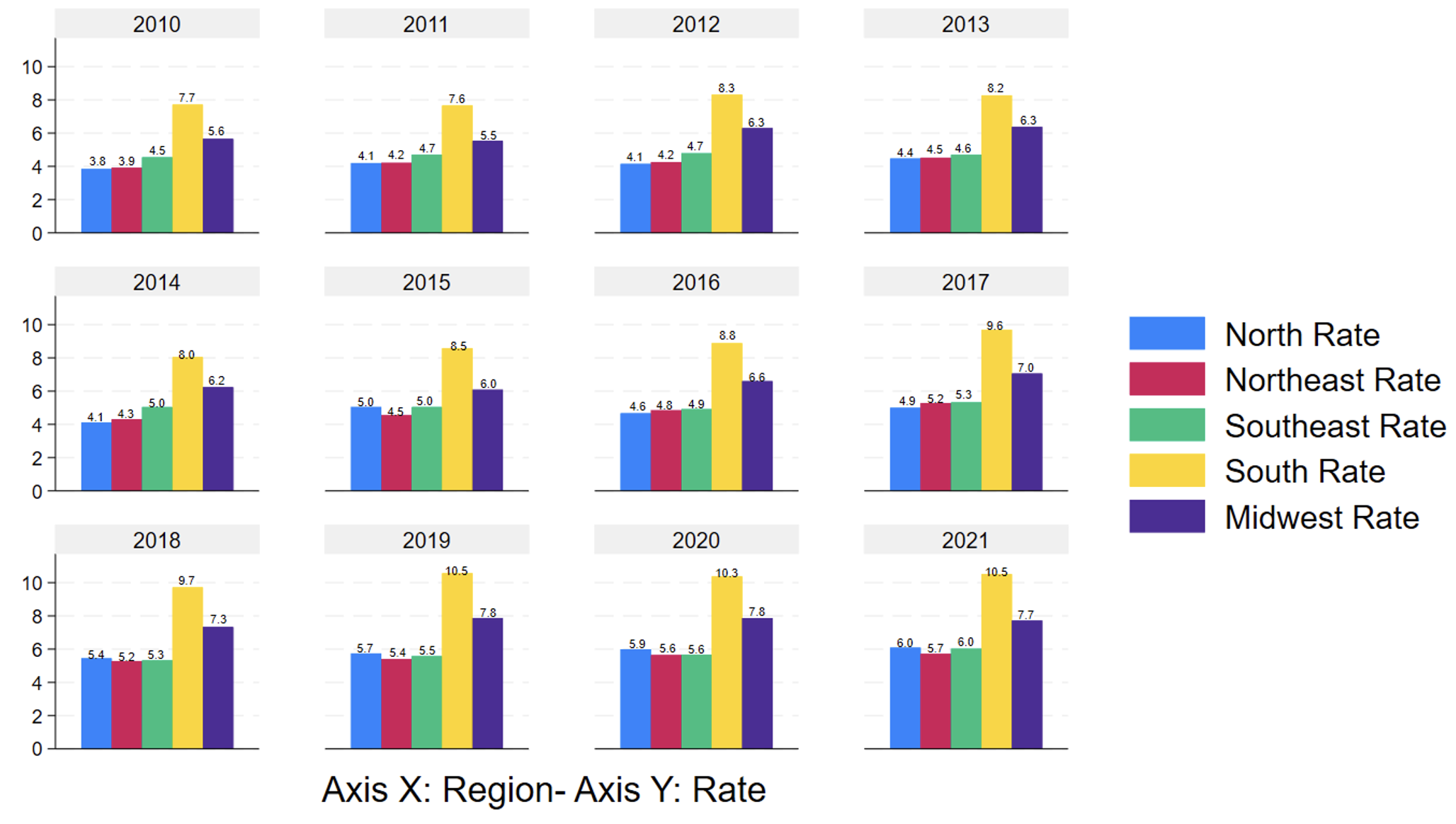Suicide mortality in Brazil: temporal analysis (2010-2021) and comparison with the first two years of the COVID-19 pandemic
Main Article Content
Abstract
Objective: To analyze suicide cases in Brazil from 2010 to 2021 and the sociodemographic characteristics of this phenomenon, including the first two years of the COVID-19 pandemic, to assess whether there was a relationship between the increase in suicide cases in Brazil and this illness. Methods: Ecological timeline study, with 140,339 cases analyzed from the Mortality Information System (SIM) databases. Rates and statistical regressions were performed using STATA® software. Results: Higher suicide rates in men, singles, and residents of the South and Midwest regions were observed. The age group of 10–19 years had an increase of 1.7 cases x 100 thousand inhabitants/year. Analysis by region revealed significant variations in rates, suggesting the influence of contextual factors. Although the pandemic affected mental health, it was not possible to establish a direct relationship between COVID-19 and increased suicide rates. Conclusion: These results reinforce the need for public policies and preventive interventions, especially for vulnerable groups such as young people. A multifactorial approach is suggested that considers socioeconomic factors, access to mental health services, and reduced stigma associated with mental illness. In short, this study contributes to understanding the temporal trends and demographic characteristics of suicides in Brazil, highlighting the importance of further longitudinal investigations to better understand this complex phenomenon. Hopefully, this evidence will strengthen mental health policies and promote more effective suicide prevention strategies.
Article Details
Authors maintain copyright and grant the HSJ the right to first publication. From 2024, the publications wiil be licensed under Attribution 4.0 International 
 , allowing their sharing, recognizing the authorship and initial publication in this journal.
, allowing their sharing, recognizing the authorship and initial publication in this journal.
Authors are authorized to assume additional contracts separately for the non-exclusive distribution of the version of the work published in this journal (e.g., publishing in an institutional repository or as a book chapter), with acknowledgment of authorship and initial publication in this journal.
Authors are encouraged to publish and distribute their work online (e.g., in institutional repositories or on their personal page) at any point after the editorial process.
Also, the AUTHOR is informed and consents that the HSJ can incorporate his article into existing or future scientific databases and indexers, under the conditions defined by the latter at all times, which will involve, at least, the possibility that the holders of these databases can perform the following actions on the article.
References
World Health Organization. Suicide: facts and figures globally [Internet]. Geneva: WHO; 2021 [cited 4 Sep 2023]. Available from: https://apps.who.int/iris/handle/10665/360460
Brzozowski FS, Soares GB, Benedet J, Boing AF, Peres MA. Suicide time trends in Brazil from 1980 to 2005. Cad Saude Pública. 2010;26(7):1293-302. https://doi.org/10.1590/S0102-311X2010000700008
Suicide: facts and figures globally [Internet]. 2022 [cited 4 Sep 2023]. Available from: https://www.who.int/publications/i/item/WHO-MSD-UCN-MHE-22.03
BRASIL, Ministério da Saúde. Boletim Epidemiológico Vol. 52 - No 48 - Português (Brasil) [Internet]. 2021 [cited 4 Sep 2023]. Available from: https://bit.ly/45U6xl3
Alves Junior CAS, Nunes HEG, Gonçalves ECA, Silva DAS. Suicidal behaviour in adolescents: characteristics and prevalence. J Human Growth Develop. 2016;26(1):88-94. https://doi.org/10.7322/jhgd.113733
Christine Moutier. Manuais MSD. Comportamento suicida - Transtornos psiquiátricos [Internet]. 2021 [cited 4 Sep 2023]. Available from: https://bit.ly/44xc7Ja
Organización Panamericana de la Salud (OPS). Prevención del suicidio [Internet]. [cited 4 Sep 2023]. Available from: https://bit.ly/3L4uGNN
World Health Organization (WHO). Suicide Prevention [Internet]. [cited 4 Sep 2023]. Available from: https://www.who.int/health-topics/suicide
Sher L. The impact of the COVID-19 pandemic on suicide rates. QJM. 2020;113(10):707-12. https://doi.org/10.1093/qjmed/hcaa202
Wasserman D, Iosue M, Wuestefeld A, Carli V. Adaptation of evidence-based suicide prevention strategies during and after the COVID-19 pandemic. World Psychiatry. 2020;19(3):294-306. https://doi.org/10.1002/wps.20801
Ertek İE, Özkan S, Candansayar S, İlhan M. The impact of the COVID-19 pandemic on the mental health of medical students. J Surg Med. 2022;6(2):162-7. https://doi.org/10.28982/josam.1061178
Brasil, Ministério da Saúde. TabNet Win32 3.0: Óbitos por Causas Externas - Brasil [Internet]. [cited 4 Sep 2023]. Available from: https://bit.ly/3RcP2Zr
Oliveira B. Séries temporais: Uma análise de suas características [Internet]. Statplace. 2019 [cited 4 Sep 2023]. Available from: https://bit.ly/44STe3L
Soto Salcedo A, Villaroel Grüner P, Véliz Burgos A, Soto Salcedo A, Villaroel Grüner P, Véliz Burgos A. Factores que intervienen en riesgo suicida y parasuicida en jóvenes Chilenos. Propós Represent. 2020;8(3):e672. https://doi.org/10.20511/pyr2020.v8n3.672
Instituto Brasileiro de Geografia e Estatística (IBGE). Projeção da população [Internet]. [cited 4 Sep 2023]. Available from: https://bit.ly/3EpOLus
Puig X, Ginebra J, Gispert R. Análisis de la evolución temporal de la mortalidad mediante modelos lineales generalizados. Gac Sanit. 2005;19(6):481-5. https://doi.org/10.1016/S0213-9111(05)71401-1
Tinoco-García MJ, Guzmán-Anaya L. Regional Foreign Direct Investment Attraction Determinants in Mexico. Anál Econ [Internet]. 2020 [cited 4 Sep 2023];35(88):89-117. Available from: https://bit.ly/45ObNHe
Machado DB, Santos DN. Suicídio no Brasil, de 2000 a 2012. J Bras Psiquiatr. 2015;64(1):45-54. https://doi.org/10.1590/0047-2085000000056
Palma DCA, Santos ES, Ignotti E. Análise dos padrões espaciais e caracterização dos suicídios no Brasil entre 1990 e 2015. Cad Saude Pública. 2020;36(4):e00092819. https://doi.org/10.1590/0102-311x00092819
Fattah N, Silva EV, Cruz CW, Amazarray MR. Perfil epidemiológico do suicídio no estado do Rio Grande do Sul, Brasil, de 2010 a 2016. Cad Saude Colet. 2021;29(4):561-74. https://doi.org/10.1590/1414-462x202129040017
Brasil, Ministério da Saúde. Boletim Epidemiológico Vol.53 No. 07 - Português (Brasil) [Internet]. 2022 [updated 5 Aug 2022; cited 4 Sep 2023]. Available from: https://bit.ly/3Laq5tP
Rocha DM, Oliveira AC, Reis RK, Santos AM, Andrade EM, Nogueira LT. Comportamento suicida durante a pandemia da COVID-19: aspectos clínicos e fatores associados. Acta Paul Enferm. 2022;35:eAPE02717. https://doi.org/10.37689/acta-ape/2022AO02717
Botega NJ, Barros MBA, Oliveira HB, Dalgalarrondo P, Marín-León L. Suicidal behavior in the community: prevalence and factors associated with suicidal ideation. Braz J Psychiatry. 2005;27:45-53. https://doi.org/10.1590/S1516-44462005000100011
Bertolote J, Botega N, de Leo D. Inequities in suicide prevention in Brazil. Lancet. 2011;378(9797):1137. https://doi.org/10.1016/S0140-6736(11)61502-X
